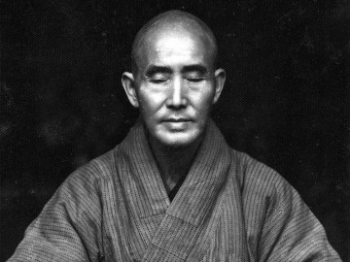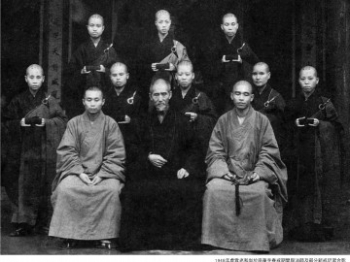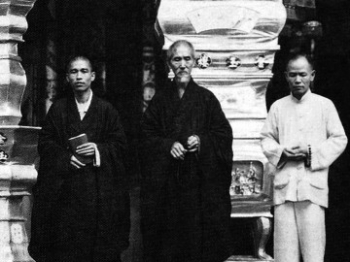The Chan master Empty Cloud (Xu Yun; 1840–1959) is known for his simple and direct teaching method. Here are some examples of his instructions to students:
“The reason for Chan investigation is to illuminate the mind so that the ‘true face’ of your self-nature can be seen. First of all, there is the need to clean the mind of its endless wandering thoughts, reactivity, and attachments. Only then can you find the Buddha’s wisdom and compassion, which already lie within your own self-nature, also called true-nature or Buddha-nature. Simply by leaving behind wandering thoughts, reactivity, and attachments, the Buddha’s wisdom and compassion will be obvious. This is known as achieving Buddhahood.
“Huatou, literally ‘word head,’ means ‘mind before thought.’ This method of investigation originates from the so-called Public Cases, or gongan, in China. These were like legal documents and in the Buddhist sense, records of interviews.The huatou is the concise, essential point of all of the gongan dialogues, asking only ‘Who’ or ‘What.’ It involves questions that demand investigation, such as ‘Who is reciting mantras?,’ ‘Who is prostrating to the Buddha?,’ ‘Who is dragging this corpse around?,’ or ‘Who is thinking of the Buddha?.’ The ‘Who’ word is the same in all of them: the answer to be found in your own mind. Within your mind are both the state of a million thoughts and the state of mind before thought. This method is very simple, ordinary, and straightforward.
“So, practicing the huatou method means just being aware of our True Mind, in other words, realizing the ‘Original Face before parents gave birth to us,’ leading to the perception of the purity of our self-nature.
“True-nature is without form or a fixed place. You can’t grab it, it doesn’t come or go, and it has no character or time or dimension. However, it is everywhere and in everything. Huatou, or ‘mind before thought,’ is exactly the one mind we all share; it is still, like empty space. It is everywhere, but it is also not anywhere to be found.
“Huatou practice is also not just about sitting in meditation, but can be done anywhere. To start, just look to see where words usually come from; look within until you can see your thoughts as separate from pure mind. Don’t interrupt the focus; be seamless, without a break. You should be serene and refined, with a luminous mind, turning away from the disturbances of greed, hatred, and delusion. Sitting, walking, standing, and lying down are all forms of this practice, as is working or eating.
“Everybody worries about wandering thoughts. I tell you explicitly, don’t worry about them, and also don’t waste time trying to stop them. Just don’t wallow in or engage with them and they will trouble you no more.
“Everything that we do in life should be seen as a form of practice, not just sitting in formal meditation. Originally, there were no meditation halls, let alone retreats or methods. People were just ‘urged’ or tricked into an awakening. However, now cannot be compared to the past; our lives and society have become complicated, so people cannot just intuitively understand straight away. In fact, the method of Chan is hard, very hard. Not many will fully accomplish it.
“There is the need for serious practitioners to adopt the practice of ‘dead guy’: one who is not moved by the Eight Worldly Winds of praise or blame, fame or disrepute, gain or loss, or pain and pleasure. There are also certain prerequisites that must be fulfilled before starting on the path of Chan. Firstly, we need a firm understanding of cause and effect. Secondly, we need to follow sincerely the moral guidelines of Buddhism. Thirdly, there must be an unshakeable belief that we can awaken to something better in ourselves, namely to full Buddhahood. And lastly, we need to choose a method and follow it faithfully without changing to another.
“The idea of ‘host and guest’ should be carefully understood. A traveler staying at an inn for the night does not stay after the next morning but simply packs and leaves. However, the host stays as he has nowhere to go. Also, a good host does not interfere with his guests. The guest signifies the part of our mind with a million thoughts, and the host is the part which is before thought. A more subtle example is ‘When light streams in through a window, you can see dust dancing in the air or clear space. Dust moves; space is still.’
“‘Guest and host’ illustrate the mind of a million thoughts and the mind before thought. ‘Space and dust’ signify the more subtle stages and progress in the training. Dust dances in space but does not disturb it; it remains unmoving and unaffected, just like the dead guy, who is no longer disturbed by the Eight Worldly Winds. If you can understand this example and practice like this, it is unlikely that you will make any serious mistakes.
“Originally, the old masters just indicated the method of seeing self-nature through direct perception.There was no huatou method—one only needed to fully accept the truth. Later, students were unable to do this, so various techniques were devised and used. Now, being unsure what our original face is, we use the ‘doubt method.’ Doubt is the crutch of huatou practice. Usually, when first practicing this method, we just think a lot of random thoughts, going with the worldly stream, but later, if we can practice with the attitude of investigating what is not born or destroyed without using thinking, hearing, or feeling, we can produce real doubt about our self-nature. This extends even to doubt about the doubt, until we break through our self-made mental bonds. Now this is called ‘going against the stream.’
“Usually, beginners have a very rough type of doubt that is really only false thinking. Once thinking slows down, true doubt will arise, and it is easy to get lost here by thinking you have a purified mind. You feel a sense of complete purity of mind and ease, so just sit comfortably. Then the doubt should be gently brought back by asking Who? or What?. To be aware like this is to have wisdom. Contemplating or looking within this state clears away any remaining confusion. This singleness of thought and of mind, a still, shining, and timeless contemplation, is spiritual clarity, with complete understanding flowing forth gently like the smoke from a fire. Reaching this stage, one has the indestructible wisdom eye. Do not let any other states manifest now, because if you do, it will be like putting another head on top of your own. This cannot be explained in words but you will definitely know your own nature, and it is quite useless trying to tell another who has not yet penetrated right through to an awakening.
“If you practice with the determination of someone who has fallen into a deep hole (he only has one thought—of escape), you will succeed in one week, but you must have the seamless type of practice mentioned above. But just sitting with an empty mind is no better than soaking a rock in water or cooking sand to make rice. You must generate the doubt and follow it through to its conclusion—only then will you succeed. Just simply illuminate the state that ‘is’ before wandering thoughts are produced, then right there examine your original face.
“The original masters shocked people straight into awakening by using wooden sticks or shouting at them (striking and shouting formerly characterized all five Chan sects). They did not talk much. But it is not like that today. I have talked too long, thereby disturbing you. Speaking simply clouds over the real meaning. All I can do is point at the moon and ask, ‘Who or what points, and what, actually, is the moon?’”
Most of the teachings here were given at the temple Zhenru Si (True Suchness Monastery) in Jiangxi Province at the end of Master Empty Cloud’s life. They are rephrased here in the author’s own words. For more information, visit Empty Cloud.

















